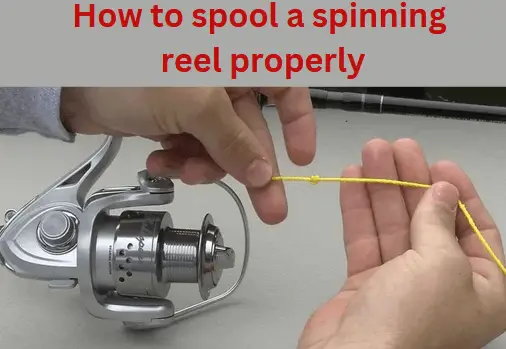To spool a spinning reel, first open the bail, and then tie the line to the spool using an arbor knot. Trim any excess line after tightening the knot to ensure a secure attachment.
Embarking on the challenge of spooling a spinning reel sets the stage for a successful fishing adventure. Precision in this foundational task is paramount, as a well-spooled reel can mean the difference between a frustrating day or a fruitful fishing trip.
Anglers know that the devil is in the details, and mastering the spooling process prevents line twists and ensures optimal casting distance and accuracy. With modern advancements in fishing gear, adapting to the correct spooling technique is more crucial than ever. Every seasoned fisherman upholds the ritual of spooling their reel with reverence and meticulous attention to elicit peak performance from their equipment. This guide lays down the necessary steps so you can spool like a pro and hit the waters ready for action.
Essentials Of Fishing Reel Setup
The spinning reel plays a critical role in fishing success. It’s the connection between you and the fish.
Choosing the right line affects casting distance and accuracy. A heavier line is durable but less subtle. Lighter lines offer finesse but may break easier. Match your line with the reel’s capacity for best results.
| Line Type | Benefits | Best Use |
| Monofilament | Stretchy, Forgiving | General Use |
| Braided | Strong, No Stretch | Heavy Cover |
| Fluorocarbon | Invisible, Abrasion Resistant | Clear Water |
Each type of line has its special properties. Understand these to enhance your fishing experience.
Preparing For Spooling
Spooling a spinning reel begins with proper preparation. Gather the necessary tools to ensure a smooth process. These include:
- A new fishing line that suits your fishing needs.
- A clean, sharp pair of scissors for trimming the line.
- Spooling tool or reel to maintain tension.
- Sticky tape to secure the line to the reel.
To understand your reel capacity, check the reel’s spool. The spool usually shows the line weight and length it can hold. Do not exceed these specs to prevent poor performance or damage. Match the line choice with the spool’s guidelines for an optimal fishing experience.
Step-by-step Guide To Spooling
Spooling a spinning reel begins by securing the reel to the rod. Ensure the reel seat is open. Place the reel foot into it. Tighten it until the reel is snug. This critical first step prevents slippage or wobble.
Next, attaching the line is straightforward. Open the bail arm. Tie the line around the spool using an arbor knot. Close the bail arm to secure it. Trim any excess line close to the knot.
Finally, winding the reel properly requires attention. Hold the line taut with one hand. Turn the handle slowly to wind the line evenly. This reduces line twists and ensures optimal performance. Continue until the line is 1/8 inch from the spool rim.
Common Mistakes To Avoid
An important step in spooling a reel is getting the right amount of line. Overfilling the spool can lead to messy tangles and line slipping off. On the other side, underfilling limits casting distance and may affect reel performance. Always ensure the line is flush with the spool’s edge for optimal results.
Line twisting is another common problem which can ruin your fishing experience. To prevent this, lay the spool flat and check the line’s direction as you reel. This method helps maintain the line’s natural orientation and minimizes twisting. Regular checks while spooling can save hours of frustration on the water.
After-spool Care And Maintenance
Proper storage of your spinning reel enhances its longevity. Keep it in a cool, dry environment away from direct sunlight. This prevents damage and maintains reel performance. Regularly place your reel on a reel stand to prevent unnecessary strain. Use a reel bag for extra protection.
Cleaning and lubrication are essential for reel care. After each use, gently wipe down your reel with a soft cloth. This removes any dirt or salt. Ensure lubrication at crucial points: the handle, spool, and drag system. Use only reel-specific lubricants. This routine keeps your reel smooth and functioning effectively. Do this process regularly.
How To Spool A Spinning Reel With Braid
To spool a spinning reel with braid, first, orient the spool correctly. Then, attach the line to the reel using the proper knot. It’s important to add electrical tape to prevent slippage. Finally, engage the reel and apply line conditioner for smoother casting.
Follow these steps to avoid line twists and tangles.
Spooling A Spinning Reel With Braid
If you’re an angler who prefers using braid on your spinning reel, it’s essential to understand the right technique to spool it. Spooling a spinning reel with braid requires some specific steps to prevent line twists and ensure that the line is properly loaded onto the reel.
Let’s explore the process of spooling a spinning reel with braid to help you get ready for your next fishing adventure.
Tips For Spooling A Spinning Reel With Braid:
- Choose the Right Knot: When spooling a spinning reel with braid, using the right knot is crucial to prevent slippage or line breakage. The double uni knot or the improved clinch knot are popular choices for securing braid to the spool.
- Use Backing Line: To prevent slippage and ensure a secure connection, consider using a monofilament or fluorocarbon backing line before attaching the braid. This technique provides a better grip for the braid, minimizing the risk of line slipping on the spool.
- Apply Tension While Spooling: Maintaining consistent tension while spooling the braid is essential to prevent line twists and ensure even distribution across the spool. Applying slight tension with your fingers or a spooling tool can help achieve a uniform line lay.
- Avoid Overfilling: Overfilling the spool with braid can lead to casting issues, backlashes, and tangles. Ensure that you leave a small gap between the braid and the spool’s rim to prevent these complications.
Spooling a spinning reel with braid demands attention to detail and precision to achieve optimal performance during fishing. By following these fundamental tips, you can ensure a smooth and effective braid spooling process, enhancing your overall angling experience.
How To Spool A Spinning Reel With Mono
Spooling a spinning reel with mono is a simple process. First, attach the line to the reel spool using an arbor knot. Then, close the bail and apply tension to the line while reeling it onto the spool. This helps prevent line twists and ensures a smooth fishing experience.
- Spooling a spinning reel with mono fishing line requires attention to detail to ensure a smooth and efficient setup:
- Begin by selecting the right mono line for your fishing needs. Choose a high-quality mono line with appropriate strength and diameter.
- Before spooling, ensure the reel’s spool is clean and free of any old line or debris to prevent tangles and knots.
- Attach the mono line to the spool by tying an arbor knot securely. Make sure the knot is tight to prevent slippage during casting.
- Adjust the tension on the line as you spool it to ensure even distribution and prevent line twists.
- Spool the mono line on the reel evenly, avoiding overlaps or gaps to optimize casting and retrieval performance.
- After spooling, trim any excess line and test the setup by casting gently to check for smooth operation.
Tips For Spooling A Spinning Reel With Mono
- To effectively spool your spinning reel with mono line:
- Maintain consistent tension while spooling to prevent loose wraps that can lead to tangles.
- Check the line alignment frequently to ensure it is evenly distributed across the spool.
- Avoid overfilling the spool with line to prevent backlash and casting issues.
- Secure the line with a proper knot and apply pressure during spooling to prevent slippage.
- Test the reel after spooling by casting in a controlled environment to confirm proper line management.
Enjoy Your Fishing Experience With Properly Spooled Mono Line
Last Word
Spooling your spinning reel properly sets the stage for a successful fishing trip. With the right technique, you can avoid tangles and enjoy smoother casting. Remember to match your line’s weight with the reel’s capacity. Embrace patience and precision, and your next catch will be just a cast away.
Happy fishing!


